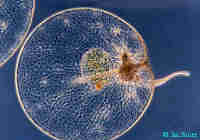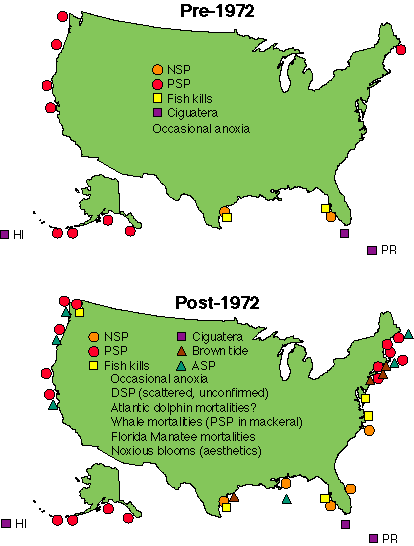
Harmful Algal Blooms
From time to time, usually in late summer, great masses of harmful marine dinoflagellates can accumulate in dense visible patches called Harmful Algal Blooms HAB in coastal regions. The dinoflagellates produce potent toxins that accumulate in marine animals.
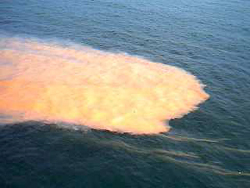
Left: A massive “red tide” bloom of the dinoflagellate Noctiluca scintillans in the North Sea near the Skagerrak in early August 2001.
From The Baltic Sea Portal (Itameriportaali).
Right: Noctiluca scintillans.
From Michaeli-Gymnasiums-München, Germany.
The Danger
Unfortunately, a small number of species produce potent neurotoxins that can be transfered through the food web where they affect and even kill the higher forms of life such as zooplankton, shellfish, fish, birds, marine mammals, and even humans that feed either directly or indirectly on them.
From Harmful Algae and Red Tides PrimerMarine biotoxins, produced by phytoplankton usually during harmful algal blooms, are some of the most potent toxins in the world and extremely dangerous. For some toxins, doses at the microgram per kilogram level are more than sufficient to kill. When enough toxin is accumulated in fish or shellfish, small amounts of cooked or raw tissue can kill a human. For example, recorded harmful algal blooms have produced enough paralytic shellfish poisoning PSP toxin in mussels that the consumption of one or two small mussels could have killed a normal, healthy adult human. While some toxins are very potent, i.e., requiring only small amounts to produce illness or death, other less potent toxins may accumulate to such high levels that they still can cause harm. For example, the total dose of domoic acid to produce a minimal toxic effect is fairly high (i.e., tens of milligrams) but it can accumulate in sufficient quantities in shellfish to produce deadly results (ranging from mild stomach distress to permanent brain damage and even death).
From NOAA Northwest Fisheries Science Center Harmful Algal Blooms Page.
- They kill fish, birds, mammals.
- They cause illness and sometimes
lead to death when people eat shellfish or fish that have concentrated
the nerve poisons produced by the blooms. The most common symptoms
include nausea, vomiting, abdominal cramps, diarrhea, and neurological
disorders. The specific illnesses are (from Harmful
Algae, Woods Hole
Oceanographic Institution).
- Amnesic
Shellfish Poisoning (ASP) is caused by species of the diatom
genus Pseudo-nitzchia,
which produce the toxin domoic acid. The toxin is concentrated by
mussels, scallops, clams, and crabs. The blooms cause health problems
along the US west coast and New England.
Amnesic Shellfish Poisoning (ASP) can be a life-threatening syndrome that is characterized by both gastrointestinal and neurological disorders. Gastroenteritis usually develops within 24 hours of the consumption of toxic shellfish; symptoms include nausea, vomiting, abdominal cramps, and diarrhea. In severe cases, neurological symptoms also appear, usually within 48 hours of toxic shellfish consumption. These symptoms include dizziness, headache, seizures, disorientation, short-term memory loss, respiratory difficulty, and coma. From Amnesic Shellfish Poisoning, Harmful Algae, Woods Hole Oceanographic Institution.
- Ciguatera
Fish Poisoning (CFP) is caused by the dinoflagellate Gambierdiscus
toxicus, which produces ciguatoxin and maitotoxin, some of
the most lethal natural toxins known. It causes health problems
in tropical waters, including Hawai'i, the Gulf of Mexico, and Puerto
Rico.
Ciguatera Fish Poisoning (CFP) produces gastrointestinal, neurological, and cardiovascular symptoms. Generally, gastrointestinal symptorms such as diarrhea, vomiting, and abdominal pain occur first, followed by neurological dysfunction including reversal of temperature sensation, muscular aches, dizziness, anxiety, sweating, and a numbness and tingling of the mouth and digits. Paralysis and death have been documented, but symptoms are usually less severe although debilitating (Miller, 1991). From Ciguatera Fish Poisoning, Harmful Algae, Woods Hole Oceanographic Institution.
- Diarrhetic
Shellfish Poisoning (DSP) is caused by the dinoflagellates
Prorocentrum lima and species of the genus Dinophysis, which produce
the toxins okadaic acid, dinophysiotoxin. It causes health problems
along the Atlantic coast of Canada.
Diarrhetic Shellfish Poisoning (DSP) produces gastrointestinal symptoms, usually beginning within 30 minutes to a few hours after consumption of toxic shellfish (Yasumoto and Murato, 1990). The illness, which is not fatal, is characterized by incapacitating diarrhea, nausea, vomiting, abdominal cramps, and chills. From Diarrhetic Shellfish Poisoning, Harmful Algae, Woods Hole Oceanographic Institution.
- Neurotoxic
Shellfish Poisoning (NSP) is caused by dinoflagellates of
the genus Karenia, especially Karenia
brevis, which secrete brevetoxins. It causes health problems
around the Gulf of Mexico.
Neurotoxic Shellfish Poisoning (NSP) produces an intoxication syndrome nearly identical to that of ciguatera in which gastrointestinal and neurological symptoms predominate. In addition, formation of toxic aerosols by wave action can produce respiratory asthma-like symptoms. No deaths have been reported and the syndrome is less severe than ciguatera, but nevertheless debilitating. From Neurotoxic Shellfish Poisoning, Harmful Algae, Woods Hole Oceanographic Institution.
- Paralytic
Shellfish Poisoning (PSP) is caused by various dinoflagellates
including species of Alexandrium, Gymnodinium
catenatum, and Pyrodinium
bahamense, which produce saxitoxin. It causes health problems
along the US west coast from Alaska to California, Hawai'i, and in
New England.
Paralytic Shellfish Poisoning (PSP), like ASP, is a life threatening syndrome. Symptoms are purely neurological and their onset is rapid. Duration of effects is a few days in non-lethal cases. Symptoms include tingling, numbness, and burning of the perioral region, ataxia, giddiness, drowsiness, fever, rash, and staggering. The most severe cases result in respiratory arrest within 24 hours of consumption of the toxic shellfish. From Paralytic Shellfish Poisoning, Harmful Algae, Woods Hole Oceanographic Institution.
- Amnesic
Shellfish Poisoning (ASP) is caused by species of the diatom
genus Pseudo-nitzchia,
which produce the toxin domoic acid. The toxin is concentrated by
mussels, scallops, clams, and crabs. The blooms cause health problems
along the US west coast and New England.
- Although not a danger, some
harmful algal blooms produce beautiful displays of bioluminescence when
disturbed at night, especially by breaking waves.
- Recently a new organism, Pfeisteria,
has been in the news because of its impact on some east coast estuaries. It
is associated with fish kills and ulcers, and with some illnesses. The
organism, its toxins, and health influences are not yet well known.
Hundreds, sometimes thousands of dead fish, their bodies disfigured by bizarre open sores--these were the press reports out of eastern North Carolina in the early Nineties. Baffled scientists tested for the usual fish kill suspects and found none ... In Maryland, a family of people working on the water reported they suffered "shortness of breath, nausea, leg sores and even memory loss," and a local doctor treated a man who "suffered a severe headache and 30 lesions after water-skiing in the lower Pocomoke for a half-hour." Doctors from the Johns Hopkins and University of Maryland medical schools examined a number of these people and concluded that pfiesteria toxins were the most likely cause of their illnesses.
From Center for Mathematics and Science Education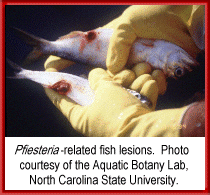
Pfiesteria-related lesions on fish.
From Environmental Protection Agency Pfiesteria Page
Dinoflagellates
Dinoflagellates are single-celled, mostly photosynthetic organisms with a nucleus (eukaroyotes). They have hairlike flagella which they use to swim through the water. To learn more about dinoflagellates, see the Tree of Life, then Eukaryotes (organisms with a cell nucleus), then Alveolates.
Causes of Blooms and Dead Zones
- Increase in nutrients. The rapid increase of population in coastal
zones and the increased use of fertilize on farms and lawns leading
to more nutrients in runoff to the ocean may be contributing to increased
blooms.
- Over fishing is an important contributor to the recent increase in toxic algal blooms and ocean dead zones. Jackson, in his 2001 Science article of on Historical Over fishing and the Recent Collapse of Coastal Ecosystems finds that:
There are three important corollaries to the primacy of overfishing... The first is that pollution, eutrophication, physical destruction of habitats, outbreaks of disease, invasions of introduced species, and human-induced climate change all come much later than overfishing in the standard sequence of historical events... The second important corollary is that overfishing may often be a necessary precondition for eutrophication, outbreaks of disease, or species introductions to occur... The third important corollary is that changes in climate are unlikely to be the primary reason for microbial outbreaks and disease... Ecological extinction of entire trophic levels makes ecosystems more vulnerable to other natural and human disturbances such as nutrient loading and eutrophication, hypoxia, disease, storms, and climate change... This is perhaps most apparent in the rise of eutrophication, hypoxia, and the outbreak of toxic blooms and disease following the destruction of oyster reefs by mechanical harvesting of oysters.
Most recent changes to coastal marine ecosystems subsequent to overfishing involve population explosions of microbes responsible for increasing eutrophication (74-76, 81), diseases of marine species (104), toxic blooms (82, 83), and even diseases such as cholera that affect human health (104, 105). Chesapeake Bay (81) and the Baltic Sea (74) are now bacterially dominated ecosystems with a trophic structure totally different from that of a century ago. Microbial domination also has expanded to the open ocean off the mouth of the Mississippi River (106) and to the Adriatic Sea (107).
Nowhere is the lack of historical perspective more damaging to scientific understanding than for microbial outbreaks. Plans for remediation of eutrophication of estuaries are still based on the belief that eutrophication is caused only by increased nutrients without regard to overfishing of suspension feeders. Even more remarkable is the attribution of the rise in marine diseases to climate change and pollution (104) without regard to the pervasive removal of higher trophic levels and the asynchronous outbreaks of disease in different ecosystems that belie a simple climatic explanation.
From Jackson et al (2001).
The number of harmful algal blooms has increased over the last 40 years, especially in regions with large increases in coastal populations and over fishing.
From Harmful Algal Bloom project, Woods Hole Oceanographic Institution.
Maps of Observed Blooms
- Europe
and North America (Drag handle on bottom right of pop-up maps
to enlarge map so it is legible).
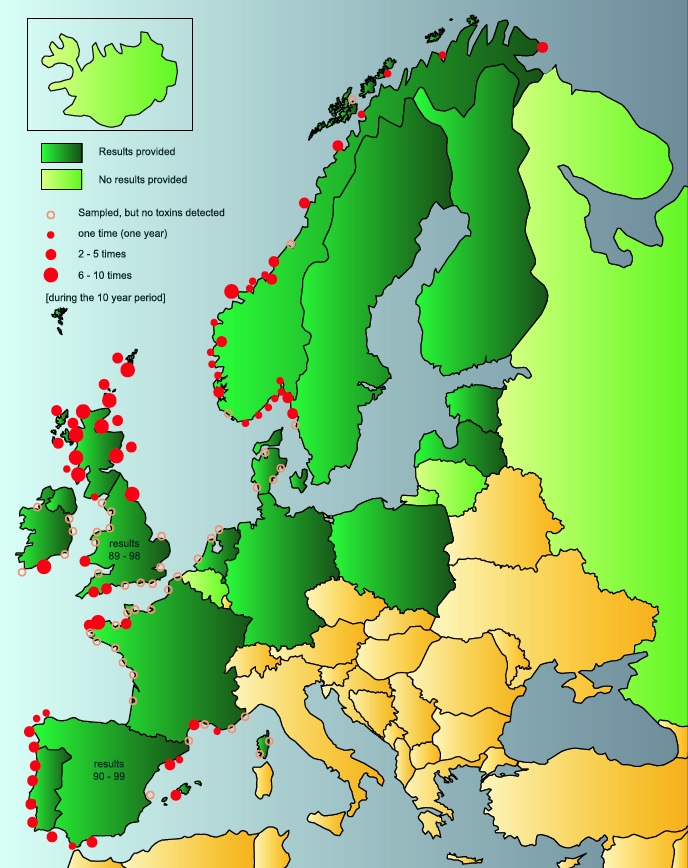
Location where Paralytic Shellfish Poisoning toxins were found in Europe 1993-2002.
- USA and World maps from the Harmful Algae web pages of the Woods Hole Oceanographic Institution.
- NOAA Maps of both historical and real-time data
- Florida Data
- Texas Information
Learn More About Harmful Algal Blooms
To learn more about these blooms, readHarmful Algae pages produced by the Woods Hole Oceanographic Institution. You may also wish to scan some of the information at the Bigelow Lab's site. But be warned. If you do, you may never again want to eat fish.
References
Anderson, Donald M. 2004. The Growing Problem of Harmful Algae. Oceanus 43 (2): 1–5.
Jackson, J. B. C., M. X. Kirby, et al. (2001). Historical
Overfishing and the Recent Collapse of Coastal Ecosystems. Science 293
(5530): 629-637.
Revised on: 27 May, 2017

